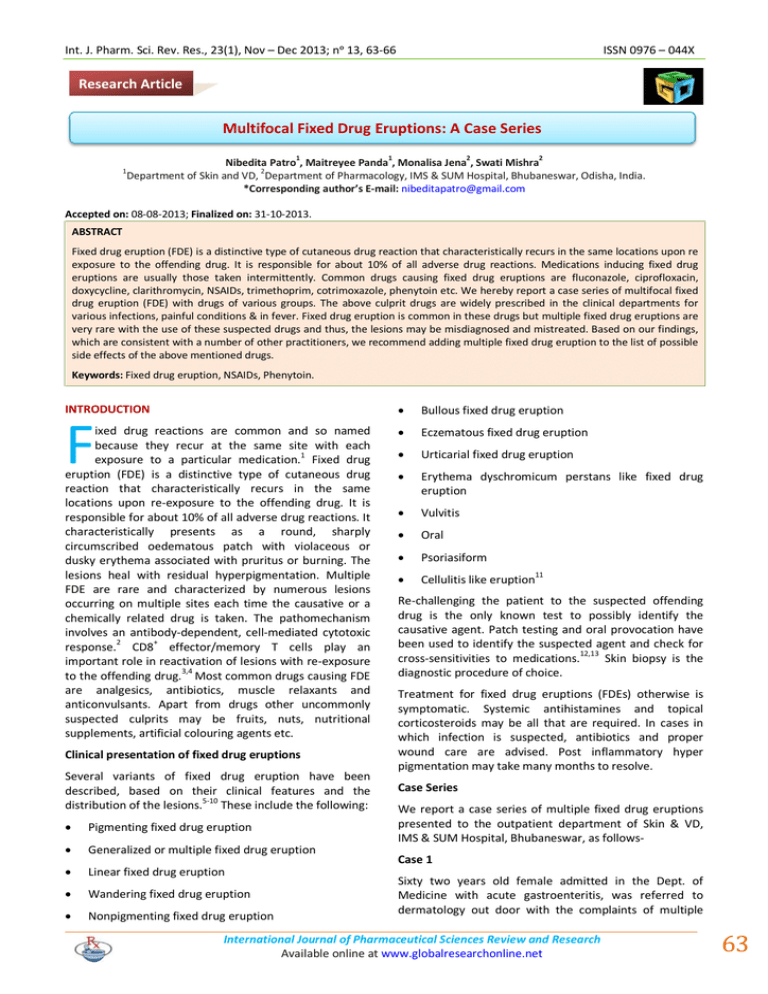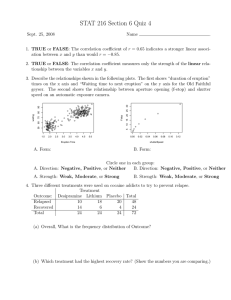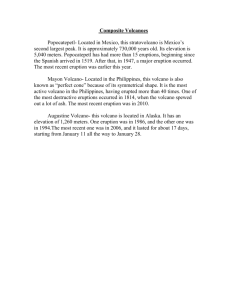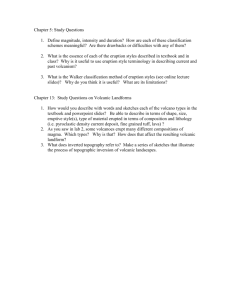Document 13309384
advertisement

Int. J. Pharm. Sci. Rev. Res., 23(1), Nov – Dec 2013; nᵒ 13, 63-66 ISSN 0976 – 044X Research Article Multifocal Fixed Drug Eruptions: A Case Series 1 1 1 2 2 Nibedita Patro , Maitreyee Panda , Monalisa Jena , Swati Mishra 2 Department of Skin and VD, Department of Pharmacology, IMS & SUM Hospital, Bhubaneswar, Odisha, India. *Corresponding author’s E-mail: nibeditapatro@gmail.com Accepted on: 08-08-2013; Finalized on: 31-10-2013. ABSTRACT Fixed drug eruption (FDE) is a distinctive type of cutaneous drug reaction that characteristically recurs in the same locations upon re exposure to the offending drug. It is responsible for about 10% of all adverse drug reactions. Medications inducing fixed drug eruptions are usually those taken intermittently. Common drugs causing fixed drug eruptions are fluconazole, ciprofloxacin, doxycycline, clarithromycin, NSAIDs, trimethoprim, cotrimoxazole, phenytoin etc. We hereby report a case series of multifocal fixed drug eruption (FDE) with drugs of various groups. The above culprit drugs are widely prescribed in the clinical departments for various infections, painful conditions & in fever. Fixed drug eruption is common in these drugs but multiple fixed drug eruptions are very rare with the use of these suspected drugs and thus, the lesions may be misdiagnosed and mistreated. Based on our findings, which are consistent with a number of other practitioners, we recommend adding multiple fixed drug eruption to the list of possible side effects of the above mentioned drugs. Keywords: Fixed drug eruption, NSAIDs, Phenytoin. INTRODUCTION F ixed drug reactions are common and so named because they recur at the same site with each exposure to a particular medication.1 Fixed drug eruption (FDE) is a distinctive type of cutaneous drug reaction that characteristically recurs in the same locations upon re-exposure to the offending drug. It is responsible for about 10% of all adverse drug reactions. It characteristically presents as a round, sharply circumscribed oedematous patch with violaceous or dusky erythema associated with pruritus or burning. The lesions heal with residual hyperpigmentation. Multiple FDE are rare and characterized by numerous lesions occurring on multiple sites each time the causative or a chemically related drug is taken. The pathomechanism involves an antibody-dependent, cell-mediated cytotoxic 2 + response. CD8 effector/memory T cells play an important role in reactivation of lesions with re-exposure 3,4 to the offending drug. Most common drugs causing FDE are analgesics, antibiotics, muscle relaxants and anticonvulsants. Apart from drugs other uncommonly suspected culprits may be fruits, nuts, nutritional supplements, artificial colouring agents etc. Clinical presentation of fixed drug eruptions Several variants of fixed drug eruption have been described, based on their clinical features and the distribution of the lesions.5-10 These include the following: Pigmenting fixed drug eruption Generalized or multiple fixed drug eruption Linear fixed drug eruption Wandering fixed drug eruption Nonpigmenting fixed drug eruption Bullous fixed drug eruption Eczematous fixed drug eruption Urticarial fixed drug eruption Erythema dyschromicum perstans like fixed drug eruption Vulvitis Oral Psoriasiform Cellulitis like eruption11 Re-challenging the patient to the suspected offending drug is the only known test to possibly identify the causative agent. Patch testing and oral provocation have been used to identify the suspected agent and check for 12,13 cross-sensitivities to medications. Skin biopsy is the diagnostic procedure of choice. Treatment for fixed drug eruptions (FDEs) otherwise is symptomatic. Systemic antihistamines and topical corticosteroids may be all that are required. In cases in which infection is suspected, antibiotics and proper wound care are advised. Post inflammatory hyper pigmentation may take many months to resolve. Case Series We report a case series of multiple fixed drug eruptions presented to the outpatient department of Skin & VD, IMS & SUM Hospital, Bhubaneswar, as followsCase 1 Sixty two years old female admitted in the Dept. of Medicine with acute gastroenteritis, was referred to dermatology out door with the complaints of multiple International Journal of Pharmaceutical Sciences Review and Research Available online at www.globalresearchonline.net 63 Int. J. Pharm. Sci. Rev. Res., 23(1), Nov – Dec 2013; nᵒ 13, 63-66 nd erythematous, itchy lesions on body developing on 2 day of admission. She had been started on intravenous ofloxacin and metronidazole along with intravenous fluids and proton pump inhibitor for acute gastroenteritis. On examination she had multiple (9 in number), round, well circumscribed, erythematous to reddish-brown patches of sizes ranging from 2 X 3 cm to 8 X 9 cm in diameter. The lesions were scattered asymmetrically over face, trunk and extremities without any mucosal involvement. Apart from gastroenteritis, no systemic abnormalities were found on routine physical and laboratory examination. Patient gave history of similar lesions in the past on 3 occasions after taking ofloxacin and metronidazole for diarrhoea. ISSN 0976 – 044X lesions) on right forearm (Figure 3). Nikolsky’s sign was negative. A diagnosis of fixed drug eruption was made on the basis of history and clinical examination. Case 2 Fifty eight years old male presented to dermatology outpatient department with recurrent history of itchy lesions on arms & back every time on taking diclofenac for headache. On examination there were multiple hyperpigmented to violaceous patches and plaques (Figure 1) with few having scaling. Mucosa was normal. Figure 1: Multiple hyperpigmented to violaceous patches and plaques with few showing scaling on back and arms. Case 3 and 4 Two patients, one 26 years old male & another 28 years old female (Figure 2) presented with multiple hyperpigmented patches on face, neck & upper limbs. They gave history of intermittent episodes of erythema & pruritus on the lesions subsiding within 4-5 days, leaving a hyperpigmented patch. On taking detailed history, a correlation was found between the episodes and intake of norfloxacin in the male and a combination of paracetamol, chlorpheniramine maleate & phenylephrine in the female. Case 5 Eight years old boy was referred from the Paediatrics outpatient department with complaints of fever and lesions on the skin and lips. The skin lesions had developed after initiating ibuprofen for fever. There was similar history once in the past on taking ibuprofen. On examination there were erosions & crusting on lips and erythematous plaques with central crusting (erythema multiforme like Figure 2: Three post inflammatory hyperpigmented patches on face and neck. Figure 3: Erosions & crusting on lips and erythematous plaques with central crusting (erythema multiforme like lesions) on right forearm scaling. She gave history of taking aceclofenac and diclofenac for fever. DISCUSSION Fixed drug eruptions (FDE) are one of the commonest adverse drug reactions encountered by dermatologists in day to day practice. Though usually not fatal, FDE can cause enough cosmetic embarrassment especially when they recur on the previously affected sites leaving behind residual hyperpigmentation. Brocq in 1984, coined the term 'fixed eruption' to describe a pattern of skin eruption due to antipyrine. The list of causative drugs is long, including non-narcotic analgesics, antibacterial agents, antifungal agents, antipsychotics, other miscellaneous drugs, and even ultraviolet radiation, emotional and psychiatric factors, heat, menstrual abnormalities, pregnancy, fatigue, cold, and undue effort.14 In the present study, the etiologies are diverse. It is very common that patients take several drugs at one time, and therefore, it is difficult to identify the true etiology. Furthermore, it is difficult to pinpoint a culprit drug in subsequent episodes considering cross and polysensitivity.14 Verbov15 reported a case of FDE caused International Journal of Pharmaceutical Sciences Review and Research Available online at www.globalresearchonline.net 64 Int. J. Pharm. Sci. Rev. Res., 23(1), Nov – Dec 2013; nᵒ 13, 63-66 ISSN 0976 – 044X 24 by paracetamol-chlormezanone combination, but not by either drug alone. patients , while the reliability of topical provocation on uninvolved skin is variable.25 Multifocal FDE is sometimes confused with StevensJohnson syndrome/Toxic epidermal necrolysis (SJS/ 16 TEN). There have been reports of patients surviving from recurrent TEN episodes but such cases are rare. Some authors even suspect that some of these cases are actually multifocal FDE rather than TEN.16 In a retrospective study in Taiwan17 it was seen that patients with multifocal FDE were older than SJS/TEN patients and may have previous episodes. They were less likely to have constitutional symptoms and mucosal involvement. In histopathology, presence of eosinophils, neutrophils, or melanophages in the superficial and deep infiltrates favours multifocal FDE over SJS/TEN.16 The absence of fire flag sign and higher eosinophil scores further differentiate FDE from SJS/TEN.16,18-19 So detailed histopathologic examination from early stage lesions or perilesional skin, along with clinical information of previous episode, constitutional symptoms and mucosal involvement, will be useful in differentiating multifocal FDE from SJS/TEN. We hereby report a case series of multifocal fixed drug eruption with various spectrums of drugs which are the common causative agents of fixed drug eruptions of single site normally. As discussed earlier, multifocal FDE might get confused with SJS/TEN due to unawareness of the entity, leading to inadvertent treatment by the physician. So, the reporting of multifocal FDE due to various drugs should be encouraged. FDE is characterized by sudden onset of sharply marginated round to oval itchy erythematous and edematous macules that evolve into dusky violaceous plaques on the skin and or mucosa arising precisely over the area of an earlier reaction due to the same drug. After an initial acute phase lasting days to weeks, a residual grayish or slate-colored hyperpigmentation develops. On subsequent exposure to the culprit drug or a chemically similar drug, few to numerous new lesions may appear which sometimes may become generalized.14 The reappearance of the lesions over the previously affected sites on re-challenge with the offending drug is considered to be a diagnostic hallmark.20 Acute lesions develop 30 min to eight hours after re-administration of the incriminating drug and usually the interval between intake of the drug to appearance of lesions is shorter with each episode. Various morphological types of lesions that may occur are morbiliform, scarlatiniform, erythema multiforme-like, Stevens-Johnson syndrome-like, eczematous, urticarial, nodular, vesicular, bullous (may become toxic epidermal necrolysis-like in severe cases), non-pigmenting and diffuse hypomelanosis.14 The pathogenetic mechanism underlying FDE is still enigmatic. The most commonly accepted hypothesis is the persistence of memory T cells in the affected skin.21 CD8+ cells phenotypically resembling effector memory T cells have been shown to be greatly enhanced along the epidermal basal layer in FDE and these have the capacity to produce large amounts of IFN gamma which is likely to 22,23 play a significant role in the development of FDE. Confirmation of diagnosis requires re-challenge with the incriminated drug by oral and or topical provocation (in the form of patch test) of which oral provocation test is considered superior but unsafe especially in patients with 14 generalized lesions. Patch testing at the site of a previous lesion yields a positive response in up to 43% of CONCLUSION The above mentioned drugs like fluoroquinolone group of drugs, NSAIDs, ibuprofen etc. which were the causative agents for development of multifocal FDE in our case series are widely administered medications in general clinical practice by the physicians. Multifocal FDE is one of the rare side effects of this group of drugs. However, it may be misdiagnosed and mistreated since many medical practitioners are unaware of this uncommon side effect. Thus, we recommend adding multifocal FDE to the list of possible side effects of the above mentioned group of drugs. REFERENCES 1. James, William, Berger, Timothy, Elston, Dirk, Andrews' Diseases of the Skin: Clinical Dermatology, 10, 2005, Saunders. 2. Teraki Y, Shiohara T, IFN-gamma-producing effector CD8+ T cells and IL-10-producing regulatory CD4+ T cells in fixed drug eruption, J Allergy Clin Immunol, 112(3), 2003, 609615. 3. Mizukawa Y, Shiohara T, Fixed drug eruption: a prototypic disorder mediated by effector memory T cells, Curr Allergy Asthma Rep, 9(1), 2009, 71-77. 4. Shiohara T, Fixed drug eruption: pathogenesis and diagnostic tests, Curr Opin Allergy Clin Immunol, 9(4), 2009, 316-321. 5. Mahboob A, Haroon TS, Drugs causing fixed eruptions: a study of 450 cases, Int J Dermatol, 37(11), 1998, 833-838. 6. Ozkaya-Bayazit E, Specific site involvement in fixed drug eruption, J Am Acad Dermatol, 49(6), 2003, 1003-1007. 7. Ozkaya-Bayazit E, Bayazit H, Ozarmagan G, Drug related clinical pattern in fixed drug eruption, Eur J Dermatol, 10(4), 2000, 288-291. 8. Fischer G, Vulvar fixed drug eruption, A report of 13 cases, J Reprod Med, 52(2), 2007, 81-86. 9. Gupta S, Gupta S, Mittal A, David S, Oral fixed drug eruption caused by gabapentin, J Eur Acad Dermatol Venereol, Feb 19, 2009. 10. Katoulis AC, Bozi E, Kanelleas A, et al., Psoriasiform fixed drug eruption caused by nimesulide, Clin Exp Dermatol, 34(7), 2009, e360-361. 11. Fathallah N, Ben Salem C, Slim R, Boussofara L, Ghariani N, Bouraoui K, Acetaminophen-induced cellulitis-like fixed drug eruption, Indian J Dermatol, 56(2), 2011, 206-208. International Journal of Pharmaceutical Sciences Review and Research Available online at www.globalresearchonline.net 65 Int. J. Pharm. Sci. Rev. Res., 23(1), Nov – Dec 2013; nᵒ 13, 63-66 12. Lammintausta K, Kortekangas-Savolainen O, Oral challenge in patients with suspected cutaneous adverse drug reactions: findings in 784 patients during a 25-year-period, Acta Derm Venereol, 85(6), 2005, 491-496. 13. Lammintausta K, Kortekangas-Savolainen O, The usefulness of skin tests to prove drug hypersensitivity, Br J Dermatol, 152(5), 2005, 968-974. 14. Sehgal VN, Srivastava G, Fixed drug eruption (FDE): changing scenario of incriminating drugs, Int J Dermatol, 45, 2006, 897-908. 15. Verbov J, Fixed drug eruption due to a drug combination but not to its constituents, Dermatologica, 171, 1985, 6061. 16. Lin TK, Hsu MM, Lee JY, Clinical resemblance of widespread bullous fixed drug eruption to Stevens-Johnson syndrome or toxic epidermal necrolysis: report of two cases, J Formos Med Assoc, 101, 2002, 572-576. 17. C.-H. Lee et al., Fixed-drug eruption: A retrospective study in a single referral centre in northern Taiwan, Dermatologica Sinica, 30, 2012, 11-15. 18. Wolff KGL, Katz SI, Gilchrest BA, Paller AS, Leffell DJ, Fitzpatrick’s dermatology in general medicine, 7th ed, New York, McGraw-Hill, 2008, 359-360. ISSN 0976 – 044X 19. Eduardo Calonje TB, Lazar A, McKee PH, McKee’s pathology of the skin: expert consult, 4th ed, 2012. 20. Ada S, Yilmaz S, Ciprofloxacin-induced generalized bullous fixed drug eruption, Indian J Dermatol Venereol Leprol, 74, 2008, 511-512. 21. Shiohara T, Nickoloff BJ, Sagawa Y et al., Fixed drug eruption. Expression of epidermal keratinocyte intercellular adhesion molecule-1 (ICAM-1), Arch Dermatol, 125, 1989, 1371-1376. 22. Shiohara T, Mizukawa Y, Fixed drug eruption: a disease mediated by self inflicted responses of intraepidermal T cells, Eur J Dermatol, 17, 2007, 201-208. 23. Shiohara T, Mizukawa Y, Teraki Y, Pathophysiology of fixed drug eruption: the role of skin resident T cells, Curr Opin Allergy Clin Immunol, 4, 2002, 317-323. 24. Barbaud A, Reichert-Penetrat S, Trechot Pet al, The use of skin testing in the investigation of cutaneous adverse drug reactions, Br J Dermatol, 139, 1998, 49-58. 25. Ozkaya-Bayazit E, Topical provocation in fixed drug eruption due to metamizole and naproxen, Clin Exp Dermatol, 29, 2004, 419- 422. Source of Support: Nil, Conflict of Interest: None. International Journal of Pharmaceutical Sciences Review and Research Available online at www.globalresearchonline.net 66







